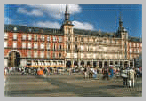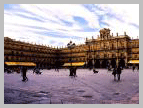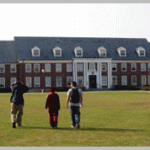Basic Education



The Education System
During the recent years the national and international society has been subjected to a series of different modifications that have affected the daily reality of the citizens. The Spanish education system offers a wide range of centres and programs which establish it as one of the most varied in Europe. The variety in study and training offers, together with an adequate equilibrium between the public and the private sector is one of the key elements of the system. The constant search and concern on the part of the public administration for the maintenance of quality in training guarantee the correct functioning of the system.
Likewise, for years now, the teaching centres have initiated a process of approximation to the real needs of the civil society and the business world, thus, looking for reinforcement and complementation between both areas.
Spain has a long tradition with regards to education. We cannot forget that our university tradition starts with the creation, in the Middle Ages, of the University of Salamanca (1218), which was followed by other important educational institutions (University of Santiago de Compostela, Universidad Complutense, amongst others) and moves forward in parallel to the impressive Spanish cultural and political history. In a more recent period, the Spanish educational system may be considered as the heir to the system installed in Europe in the 19 th Century, and as time has gone by the Spanish system has become much more decentralized an agile, without loosing sight of the strive to achieve academic and teaching quality and excellence.
As opposed to other European educational and training systems, Spain has managed to maintain and encourage an equilibrium between the private qualifications in study and training centres —at any of the levels, elementary and mandatory education, middle school and higher education –and public qualifications. The main result of this equilibrium is the plentiful and wide variety of training possibilities. All of them have a common denominator: the conviction that internalization, the opening of study and training centres and the unrelenting strive for quality are the pillars that support the future of the Spanish education system which is immersed in a globalized world.
Without a doubt, the Spanish language — shared by more than 400 million people and the official language in 21 countries –as the main working instrument in the system is an asset that has to be taken into account when envisioning a training itinerary.
Infant School
Infant school, for children up to six years of age, contributes to the physical, intellectual, affective, social and moral development of children. Infant school is comprised of two cycles. The first cycle for children up to 3 years of age, and the second, from three to six years of age.
Primary Education
Primary education comprises six academic courses, from 6 to 12 years of age, organized in 3 cycles, each of them 2 years long. It is a mandatory and free educational stage. Its aim is to promote socialization among boys and girls, ease their incorporation into the culture and contribute to their progressive autonomy of action within their environment. The education is organized in Areas, taught by Teachers.
Mandatory Secondary Education
The ESO (Mandatory Secondary Education) extends over a four year span after the PRIMARY EDUCATION stage. It provides the necessary training to continue studies either in the Baccalaureate or in a Middle Grade Vocational Training. The student body starts this stage at twelve years of age, and finishes it when they are sixteen.
The Baccalaureate
The Baccalaureate is the last stage of Secondary Education, it is voluntary and it last for two courses, usually between the ages of 16 and 18. The Baccalaureate has four different options, which have been established to meet either the diversity of subsequent studies or the variety of interests, capabilities and aptitudes shown by teenagers at this age. The four options are as follows: Arts; Health and Nature Science; Social Sciences and Humanities; Technology. The completion of this stage grants the student the Baccalaureate Diploma (Título de Bachiller).
Vocational training
Vocational training, within the educational system, is aimed at the training of students for an activity in a professional sector, providing them with a polyvalent training that will allow their adaptation to work related modifications which they may encounter throughout their life. It includes both base vocational training and specific vocational training of middle and higher grade.
Artistic Trainig - Music and dance
Music and dance training comprises three grades:
![]() Elementary grade, lasting 4 years.
Elementary grade, lasting 4 years.
![]() Middle grade, structured in three cycles each lasting two academic years.
Middle grade, structured in three cycles each lasting two academic years.
![]() Higher grade, comprised of one unique cycle whose duration in based on the specific characteristics of the training.
Higher grade, comprised of one unique cycle whose duration in based on the specific characteristics of the training.
Elementary grade:
For the elementary grade in music and dance training, the Education Board establishes admissions criteria that take into account, amongst other circumstances, the ideal age at which to go through this kind of training.
Middle grade:
In order to be admitted in the middle grade of music and dance training, students have to pass a specific admissions test. Completing the third cycle of the middle grade of Music or Dance grants the right to the professional diploma of the corresponding training.
Higher grade:
A student may be admitted in the higher grade of music and dance training if he/she meets the following pre-requisites:
– To have the baccalaureate diploma.
– To have passed the specific admissions test established by the Government, in which the aspiring student must demonstrate the necessary knowledge and professional ability to benefit from the corresponding training.
– Students who complete the higher grade of these trainings will be granted the right to the Higher Diploma (título Superior) of the corresponding specialty. This Diploma, is equivalent, in all respects, to the Título de Licenciado Universitario (University Graduate Decree from a 5 year degree).
Artistics Trainig - Drama
Drama studies comprise one unique higher cycle, whose duration is adapted to the characteristics of the corresponding studies. In order to be admitted into drama studies, the student needs to:
– Have the baccalaureate Diploma.
– Have passed the specific admissions test established by the Government which will evaluate student’s maturity, knowledge and abilities that are necessary to benefit from these studies.
Students who complete their drama studies have the right to the Higher Diploma In Drama Studies (título Superior de Arte Dramático), equivalent, in all respects, to the Título de Licenciado Universitario (University Graduate Degree from a 5 year degree).
Artistic Trainig - fine arts and design
The studies of fine arts and design comprise studies relating to applied arts, artistic professions, design in its various modalities and conservation and restoration of cultural heritage pieces.
To be admitted into the medium grade cycles in fine arts and design studies, it is necessary to have obtained the Diploma of Graduation from Secondary Education (título de Graduado en Educación Secundaria), and demonstrate the necessary aptitudes by passing the tests established for this purpose.
High grade cycles may be accessed by those who have the Baccalaureate Diploma and have passed the established tests. The studies corresponding to the specialty of Conservation and Restoration of Cultural Heritage are considered as higher studies. Students who complete these studies obtain the Diploma in Conservation and Restoration of Cultural Heritage (Título de Conservación y Restauración de Bienes Culturales), which is equivalent, in all respects, to the título de Diplomado Universitario (University Graduate Degree from a 3 year degree).
Studies in design are considered higher studies. At the end of the Design studies students obtain the Diploma in Design (título de Diseño) in the corresponding specialty, which is equivalent, in all respects, to the título de Diplomado Universitario (University Graduate Degree from a 3 year degree).
 Español
Español 